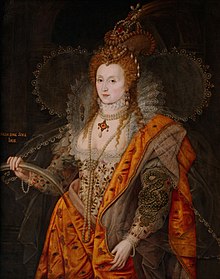Bacton Altar Cloth

The Bacton Altar Cloth is a 16th-century garment that is considered the sole surviving dress of Queen
Description

The garment is made of cream-coloured silk and Italian cloth of silver.[4] Cloth of silver was, under Sumptuary Law, reserved for members of the royal family, which was an early clue of its origin.[5] It was elaborately embroidered with colourful flowers and vegetation in silk, silver and gold thread, including caterpillars and deer.[6] Unusually, the embroidery was stitched straight onto the fabric, indicating expert workmanship and therefore an elite owner.[7] Dye used in the embroidery thread included cochineal red from Mexico,[8] evidence of early trade from North America, as well Indian indigo blue traded through Portugal.[2]
History of the dress


The dress dates to late in Queen
It seems possible that the garment was given to Bacton Church by the courtier
The Altar Cloth had survived the centuries as it was considered a sacred object by the parishioners at St Faith's Church in Bacton. Its probable connection to Blanche Parry and the court of Elizabeth I was never forgotten,[11] and in the 1870s it was thought that Blanche Parry had embroidered the cloth herself,[12] for one of her own dresses to wear at court.[13]
Rediscovery
The Bacton cloth was exhibited in London by T W. Colt Williams at a meeting of the Royal Archaeological Institute on 4 June 1885.[14] It was also shown at the Society of Antiquaries on 18 June 1885. In 1909, the cloth was framed in oak and mounted on the wall above the pews. Nearby is the Blanche Parry Monument, the earliest depiction of the Queen as Gloriana. For 106 years the framed cloth remained on the north wall of Bacton Church, away from direct sunlight, which helped preserve the garment from fading.
In the early 20th century, Sir
Return to prominence
In 2015, the garment was researched by Ruth Elizabeth Richardson while writing a new biography of
Following display at Hampton Court in 2019-20, the cloth subsequently went on display as part of The Tudors: Passion, Power and Politics at National Museums Liverpool from May to August 2022 and later at Guildhall Art Gallery from September to December 2023 as part of the Gold and Silver Wire Drawers 400th anniversary celebrations.[18]
See also
References
- ^ "The Bacton Altar Cloth". Historic Royal Palaces. 15 May 2016. Retrieved 5 November 2019.
- ^ a b c "Remnants of Queen Elizabeth I's sole surviving dress discovered in a rural church". CBC. 23 October 2018. Retrieved 5 November 2019.
- ^ Alberge, Dalya (11 August 2019). "Elizabeth I's lost dress to go on display at Hampton Court after thousand hours of conservation work". The Daily Telegraph. Retrieved 20 April 2020.
- ^ Murphy, Victoria (13 October 2019). "How Queen Elizabeth I's Only Surviving Dress Was Discovered in a Rural Church". Town & Country. Retrieved 5 November 2019.
- ^ a b c "The Lost Dress of Elizabeth I". Historic Royal Palaces. 20 September 2019. Retrieved 5 November 2019.
- ^ Passino, Carla (12 August 2019). "A centuries-old altar cloth from a rural English church turned out to be the 'lost dress' of Elizabeth I, and it's set to go on public display". Country Life. Retrieved 20 April 2020.
- ^ a b Howard, Victoria (11 October 2019). "The Bacton Altar Cloth – Elizabeth I's only surviving dress – now at Hampton Court Palace". The Crown Chronicles. Retrieved 4 May 2020.
- ^ Eleri Lynn, Tudor Textiles (Yale, 2020), p. 26.
- ^ Eleri Lynn, Tudor Textiles (Yale, 2020), p. 67.
- ^ George Ballard, Memoirs of several ladies of Great Britain (Detroit, 1985), p. 186.
- ^ Jean Wilson, The Archaeology of Shakespeare : The Material Legacy of Shakespeare's theatre (Sutton, 1995), 131.
- ^ 'Blanche Parry', Notes & Queries, 4th series, X (2 July 1872), p. 48.
- ^ Sybil Cust, Queen Elizabeth's gentlewoman, and other sketches (London, 1914), pp. 30-1: Ruth Elizabeth Richardson, Mistress Blanche: Queen Elizabeth I's Confidante (Logaston Press, 2007), p. 62: Edward W. Colt (Williams),'Notes on the Bacton chalice', Transactions of the Woolhope Naturalists' Field Club (hereford, 1892), p. 233
- ^ The Archaeological Journal, 42 (London, 1885), p. 477, probably 'Edward W. Colt (Williams)'.
- ^ Sybil Cust, Queen Elizabeth's gentlewoman, and other sketches (London, 1914), pp. 3-33
- ^ Lionel Henry Cust, 'Queen Elizabeth's Kirtle', The Burlington Magazine, 33:189 (December 1918), pp. 196–201.
- ^ Arnold, Janet (1988). Queen Elizabeth's Wardrobe Unlock'd. London: Maney.
- ^ "Queen Elizabeth I's silver thread dress going on display in the City of London". ianvisits. 15 June 2023. Retrieved 16 June 2023.
Further reading
- Richardson, Ruth Elizabeth, Mistress Blanche Queen Elizabeth I's Confidante, (first edition 2007) second edition 2018, Logaston Press, Eardisley, Herefordshire.
- Richardson, Ruth Elizabeth, "Elizabeth I's Earliest Influences: New Discoveries Concerning Blanche Parry, Lady Troy, the Funeral Monuments and the Bacton Altar Cloth", The Court Historian, May 2020.
- Lynn, Eleri, 'The Bacton Altar Cloth: Elizabeth I's 'long-lost skirt'?', Costume, 52:1 (March 2018), pp. 3-25.
- Lynn, Eleri, Tudor Fashion, 2017, Yale University Press, New Haven and London, in association with Historic Royal Palaces.
- Arnold, Janet, Queen Elizabeth's Wardrobe Unlock'd, 1988, Maney.
